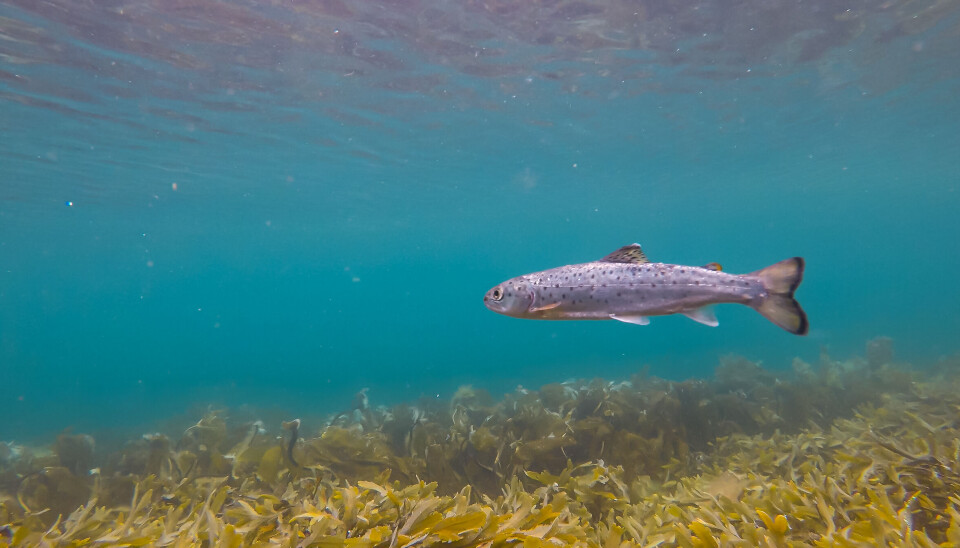Northern Norway experiences explosive increase in sea lice
The populations of the parasite have never been higher in the region than now, says marine researcher Anne Sandvik

Every week, marine researcher Anne Sandvik collects data on how many sea lice there are on farmed fish. These are reported by the farmers, Norway's Institute of Marine Research (IMR) writes on its website.
She uses the numbers to calculate how many lice escape from fish farms and where they drift with the ocean currents - before they have grown into infectious lice that can attach to fish.
"In the north, we saw an explosive increase and a multiple of the number of lice larvae this summer," says the researcher.

Particularly affects trout and char
The timing of the increase means that sea trout especially may have been exposed to lice attacks, claims the marine researcher.
"When the louse larvae have developed into infectious copepodites, they are ready to attach themselves to salmon, sea trout, or char," says Sandvik.
While the salmon swim out to sea in early summer, the other two species graze over a longer period in the fjords and along the coast. The researcher believes that the sea trout may be particularly vulnerable since they stay further out in the fjord than the char.
"The risk of sea trout being infected with harmful amounts of lice has increased in recent weeks," believes Sandvik.
As an example, she points out that in week 30 (July 22-28) there were more than twice as many adult female lice on the farmed fish in production area 8 (PO 8) than at the same time in 2023. Norway's coast is divided into 13 fish farming production areas, from PO 1 in the south to 13 in the far north.
Sandvik says salmon lice feed on the fish, and in the worst case, fish that get many lice on them die.

Temperature blamed
"The large increase in the north is probably due to the high sea temperature this summer. It has provided the lice with very good living conditions," says Sandvik.
The pace of the life cycle of the salmon louse depends on the temperature. At high temperatures, it accelerates, meaning the lice mature faster and start reproducing sooner. Additionally, their ability to attach to a fish increases with rising temperatures. This leads to more lice, both adult and younger, simultaneously.
As warm as Western Norway
In the north, the sea temperature has been higher than normal this summer. This is also clearly shown at IMR's permanent stations for temperature measurement.
At one of the permanent stations, Eggum, a temperature of 16.85 degrees Celsius was recorded in August. Normally, the temperature here, on the outer side of Lofoten, is around 12-13 degrees, says Sandvik.
The sea temperatures measured in the north this year are about the same as those usually found in Western Norway.
In addition to IMR's permanent stations, researchers have access to temperature measurements from fish farmers via the Barentswatch website.
"Fish farmers measure temperature at a depth of 3 metres, these are also included when we calculate the amount of sea lice. The temperature at 3 metres has been 3-4 degrees above what is usual in the north, which has given the lice a huge advantage," says Sandvik.
Millions of larvae per farm
Although sea lice are naturally found in the sea, most of the lice now come from salmon farms, claims the marine researcher. And this year, an unwanted production record is being set in the north.
But how many lice can there be in a fish farm?
"If we assume that a single cage contains between 100,000 and 200,000 fish, and each of these has 0.5 adult female lice (which is the legal limit from week 27 in the north), this cage will have 50,000 to 100,000 adult female lice before there is a requirement to delouse the fish," explains Sandvik.
In recent weeks, many facilities have reported increasing amounts of adult female lice, and for example in PO 12 there are now four times as many female lice as there have been in recent years. In week 34 (August 19-25), 56 of 558 facilities along the Norwegian coast had more lice than allowed (source: Barentswatch).
No change in the south
In the south, the water temperature has been about the same throughout the summer. Although the total number of adult female lice is as high or higher than in the north, it is not higher than it has been in recent years.
In addition to calculating the number of salmon lice and how they spread, the Institute of Marine Research monitors the amount of salmon lice on wild salmonids (salmon, sea trout, Arctic char) in selected areas along the coast. In the spring, the temperature increases in the south first, somonitoring starts here first. The results from the monitoring in the north are not yet quality assured, but will be available during the autumn.